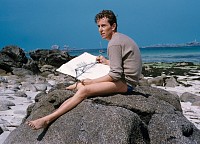BIOGRAPHY

Buffet was born in Paris and studied art at The Ecole des Beaux Arts in France but preferred to work by himself in solitude. He was a highly prolific artist and created over 8,000 paintings, etchings, lithographs, illustrations and sometimes sculptures.
Early in his professional career, Buffet developed his unique style of rendering forms with spikey, angular outlines. His subject matter included religious scenes, portraits and still-lifes. His work during the 1950s expressed the existential sentiments of post-war France often with muted colors and long thin faces. During this period, his work became extremely popular and he was he was considered a rival and peer to Pablo Picasso. After he gained success, Buffet's work became more decorative and included city scenes, paintings of owls, and still-lifes of flowers in bold, bright colors that were not recieved well by critical audiences at the time.
He developed Parkinsons later in life and commited suicide in 1999 after he was no longer able to paint.
In 1973, due to his large number of supporters in Japan, the Bernard Buffet Museum opened in Tokyo, Japan and is still open today. Following his first retrospective at the Musee d’Art Moderne de la Ville de Paris in 2016, Buffet has seen a resurgence in popularity as contemporary viewers respond to the graphic style and bold colors of his artwork.
Buffet’s artwork is in the collections of the Tate Gallery, Getty Museum, the Fine Arts Museum of San Francisco, National Gallery of Canada, ARTAX Dusseldorf, among others.
